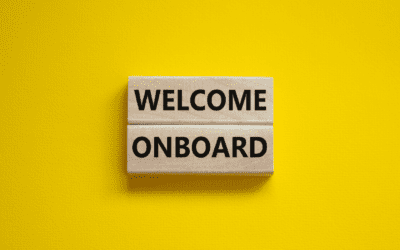Have you ever walked into your office only to be met with yet another set of unfamiliar faces? It’s becoming a bit like Groundhog Day, right? Well, trust us, it’s not just you. Holding onto new talent often feels like trying to keep water cupped in our hands—no matter how tightly we clasp, some of it always seems to slip through the cracks.
But as we’ve learned from experience, onboarding is so much more than a simple introduction; it’s the golden ticket to nurturing commitment and sparking enthusiasm in those bright-eyed newcomers.
Stay cozy and get ready for an invaluable exploration into employee onboarding that could very well turn the tide for your team dynamics. Keep an eye out because these insights have the potential to transform your company’s future one great hire at a time.
Key Takeaways
- Good onboarding makes new employees feel welcome and important. It helps them learn quickly and stay with the company longer.
- If we onboard well, new hires are 82% more likely to stick around. This saves time and money because we don’t have to keep hiring new people.
- In the first 45 days, it’s key that new team members get comfortable. This is when many decide whether they’ll stay or go.
- Onboarding boosts productivity by up to 50%. New hires can do their best work sooner if they have what they need from the start.
- Regular check-ins help us fix problems fast. They make sure everyone feels like part of the team and knows how to succeed in their job.
Understanding Employee Onboarding
Employee onboarding is our way of bringing new hires into the fold. Think of it like a bridge connecting them to their roles with us, helping them become part of the team faster. We show them how we do things around here—our workplace culture, expectations, and where they can find what they need.
It’s not just paperwork; it’s introducing them to co-workers, setting up their workspaces, and giving them a real sense of belonging.

We take this seriously because we know it makes a huge difference. Good onboarding leads to employees feeling confident and appreciated right off the bat. They get comfortable quicker and start contributing in meaningful ways sooner.
It lays down roots for long-term relationships between staff and company—key ingredients for that exceptional onboarding experience everyone talks about.
Enhancing the comfort and confidence of new hires

We make sure new hires feel at home right from the start. It’s like giving them a key to join the family, not just a badge for entry. A friendly smile, a well-prepped desk, and clear guidance on their first day kick things off right.
We walk them through our culture, introduce them to teammates, and map out their first week with precision. This approach isn’t just about being nice; it’s strategic too.
A confident new employee will dive into tasks with gusto and share fresh ideas fearlessly. They know we’ve got their back, so they’re willing to reach further. By investing in comfort early on, we see folks stick around longer—evidence suggests that smashing onboarding can boost retention by 82%.
That means less time refilling positions and more time hitting those big goals as a team!
Fostering a sense of appreciation in new hires
Our onboarding process includes specific steps to make new hires feel valued. They get a warm welcome and are shown how their role contributes to the company’s success. We let them see their work matters by giving feedback early on.
This builds trust and shows we appreciate their efforts.
Through such experiences, new employees quickly feel like part of our team. They understand they’re not just filling a position; they’re essential to our mission. By recognizing their contributions, we boost their engagement from day one.
Now let’s look at how effective onboarding ramps up productivity for new hires.
The Impact of Effective Onboarding on Employee Productivity
When onboarding new team members effectively, we’re not just showing them the ropes—we’re supercharging their journey to peak productivity! Indeed, a well-crafted onboarding experience is the secret sauce that helps fresh faces hit the ground running and deliver results faster than you can say “Welcome aboard.”
The role of onboarding in optimizing new hire productivity
Onboarding is a game-changer for getting new hires up to speed. We ensure they know the ropes so they can dive into work confidently and efficiently. With a well-crafted onboarding program, we see productivity jump by as much as 50 percent right off the bat.
It’s all about giving them the tools and knowledge they need from day one.
Good onboarding doesn’t just throw information at newcomers; it nurtures their skills and integrates them into our company culture smoothly. This approach ensures every newcomer feels like part of the team quickly, setting them up to contribute in meaningful ways quickly.
Next up: why those first 45 days are super important for new employees.
The criticality of the first 45 days in onboarding
The first month and a half is make-or-break for new hires. A staggering 20% of staff turnover happens during this time. That’s why we focus on making those days count. We shape an exceptional onboarding experience to keep them around longer.
Every moment matters, from feeling welcomed to mastering skills.
We’ve got strategies that turn newbies into long-term team players. Getting folks comfortable, confident, and connected early sets the stage for their success. It’s all about preparing them to dive deep into their roles quickly and effectively.
After all, solid beginnings are our launchpad for retention and productivity—now let’s talk about turning these critical first days into winning strategies that stick.
Successful Onboarding Strategies
Alright, folks – let’s dive into the playbook of winning onboarding strategies. These powerhouse moves are all about setting up our new teammates for success from the get-go, ensuring they’re not only sticking around but also knocking it out of the park productivity-wise.
Keep reading to gear up your game plan!
Completing necessary tasks before the employee’s start date
We make sure all the paperwork is done before our new team member steps in. Setting up their email, workstation, and access to necessary tools helps them hit the ground running. We want them to feel ready from day one.
We also create a schedule for their first week. This includes meet-and-greets, training sessions, and time to learn about our company culture. It’s all about giving them the keys they need to thrive immediately.
Now let’s talk about preparing a robust welcome plan.
Implementing a robust welcome plan
Creating a strong welcome plan is like rolling out the red carpet for new team members. It shows we value them from day one. In our welcome plans, we include personalized greetings, company swag, and a detailed schedule for their first week.

This helps new hires feel part of the team quickly.
We take them on office tours, introduce them to colleagues, and ensure their workspace is all set up. These steps build confidence and comfort. They jump into becoming productive members because they know what’s expected and who can help them learn the ropes.
With a strong start, they’re more likely to stay with us long-term.
Regular check-ins during the onboarding process
We make sure to touch base with new team members often. This helps us figure out if they’re settling in well. We ask questions like “Do you feel comfortable with your tasks?” and “What does success look like for your role?” It’s a simple, yet powerful way to keep everyone on track.
Research shows that this approach can lift retention by a whopping 82%. That means fewer people leave and more stay to grow with our company.
Regular check-ins also give us the chance to clear up any confusion right away. We take pride in creating an environment where asking questions is encouraged. Every conversation is a step toward building stronger connections between colleagues and their work.
Now, let’s explore how the first 45 days shape a newbie’s journey at our place.
The Consequences of Poor Onboarding
Poor onboarding is like starting a race with a twisted ankle—it just sets you up for trouble. Imagine this: 6 out of every 10 managers watch their new hires walk out the door, all because those first crucial weeks were mishandled.
It’s not just about losing people; it’s like watching your hard work and resources drain away, bumping up that turnover rate when it could have been avoided.
Now picture your team grappling with tasks they’re supposed to do but can’t, simply because nobody showed them how. This is what happens in too many small companies—they bring on new folks and throw them into deep water without teaching them how to swim.
And get this—to make matters worse, 80% of employees feeling neglected by poor onboarding are already eyeing the exit sign, especially if they’re remote workers feeling stranded on an island without support.
Their productivity takes a nosedive, dragging down employee engagement along with it. We need to give our teams the know-how from the start to expect them to stick around or give their best.
Conclusion
We now understand how vital onboarding is for keeping our team together and working at their best. Remember, a solid start leads to lasting loyalty and sharper skills. Let’s create exceptional onboarding experiences—our success depends on it.
This isn’t just about first impressions; it’s about building the foundation for a thriving workplace today and tomorrow. investing in those early days will pay off big time with a dedicated and dynamic crew!
Frequently Asked Questions
1. Why does a great onboarding experience help keep employees longer?
A strong start with exceptional onboarding experiences can boost job satisfaction, which often leads to lower employee turnover. Employees who feel valued and understand their role from day one are more likely to stay.
2. How does onboarding improve an employee’s productivity?
Through onboarding, new hires gain the know-how quickly and efficiently – think microlearning or mentorships that pinpoint skill development. This kind of training gets them up to speed so they can contribute faster and better.
3. Can LinkedIn play a part in improving the hiring process?
Absolutely! LinkedIn is like a treasure chest for human resources professionals — you’ve got resumes, social media presence, and even endorsements all in one spot. It streamlines talent management by connecting employers with potential candidates effectively.
4. Do perks make a difference in how long an employee stays?
Perks are more than just goodies; they’re part of the employee value proposition – showing workers what’s in it for them beyond salary alone at your company supports career development but also ties directly to workplace culture and employee satisfaction.
5. Will focusing on environmental, social, and governance (ESG) factors affect retention rates?
You bet – ESG reflects your company’s values regarding corporate social responsibility; giving attention here shows employees you care about more than just profits. That sense of purpose? It fights off feelings like loneliness at work which can lead to absenteeism or even quitting.
6. Is there any link between browsing habits during onboarding and productivity?
Interestingly enough, tracking unique visitors’ interaction through cookies–like session cookie bookie–on your website reveals patterns: landing pages viewed indicate interests or uncertainties new hires have; addressing these areas early through targeted training enhances their overall performance.



0 Comments